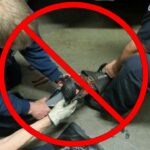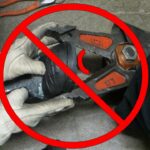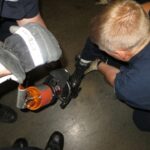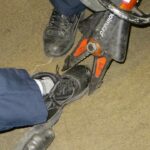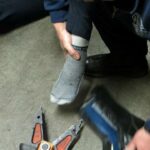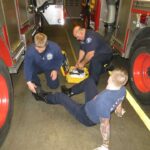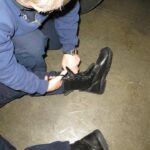
By Raul A. Angulo
Okay, I know this is a crazy title for a drill, but there is a story behind it. Sometime last year (before I retired) Ladder 6 was part of a full response. I unzipped my 12-inch station boots, jumped into my firefighting boots and pants along with the rest of my PPE firefighting ensemble, and off we went. Upon returning to quarters, Dino, my driver, took the turn into the apparatus bay a little wider than normal and ran over one of my boots with Ladder 6. I didn’t notice it until I tried to put my boot back on, but the steel toe was smashed! (I thought it looked a little funny). “Dino! Whiskey-Tango-Foxtrot! Look what you did to my boot! They’re not even six months old!” The back and forth salvos immediately started for who was at fault. I had to wear slippers for the rest of the shift.
RELATED
Rescue Is Not Always Technical
As I looked at my deformed boot, I thought about a call I had back in the 1980s. A worker at the Burlington Northern rail yard had a large steel container fall on his foot and smashed his boot (the steel toe) onto his toes. That is why labor and industry laws require steel-toe boots. We used pry bars and hydraulic jacks to lift the container off the worker’s foot, but at the time we didn’t have the right tools to free his foot from the boot and his toes were pinched tight. The decision was made by the paramedics to transport the patient to the emergency room with the boot on. I don’t recall what ever happened to him.
I made a few calls to the ER physicians in the area, as well as to two personal friends who are emergency room doctors in other states, and presented them with the same scenario. The question was, “Do you want us to remove the boot at the scene or transport the patient with the boot on to the emergency room?” The consensus was unanimous. Remove the boot at the scene. The doctors stated if the steel-toe portion of the boot was tightly crimped around the toes; they do not have equipment in the ER strong enough to bend steel. They would make the decision to call the fire department back to the ER to remove the boot, which would only delay treatment to the patient. That was good enough for me.
The next shift I relayed the news to my crew and decided to make good use of my newly-deformed boot. I wear a size 13, so I picked the crew member with the smallest feet to put the boot on and play the patient. I wanted to come up with an extrication plan and experiment using the hand-held combi-tool. Since the member’s toes were not under the steel cap, there was no danger of pinching him, but he would be able to feel the sensation as to whether the steel cap was opening or remaining the same.
The first thing we did was lay the patient down, reassure him, and get a set of vitals while the other crew member cut away the leather boot to expose as much of the foot as possible.
Then we checked for obvious injuries and bleeding. We also checked for distal pulses. We would ask the patient if he could wiggle his toes and see if we could manually assist in freeing his foot in addition to assessing how severe the steel cap was smashed against the toes.
Assuming he could not move his toes, we decided to use the hand-held combi tool because it was the best tool with slow and precise control while having the power to manipulate steel.
The logical position to start was the underside of the boot. We figured if we compressed the sides of the cap, it would open up–creating a space for the toes to slip out. However, as the blades compressed the side of boot, the member could feel the bottom steel shank was bowing up against the bottom of his foot, which was creating more pressure instead of less. So that was not the way to go.
We decided to try coming down from the top of the boot on to the steel cap, then gently started applying compression to the side of the boot, and that seemed to work. My firefighter could actually feel the steel cap opening up creating sufficient space that he could actually slip his entire foot into the tip of the boot.
To confirm this technique, we deliberately ran over the other boot with Ladder 6 and took it over to the work bench. We cut away the all the leather and exposed the steel cap over the toe. Once again, we compressed the jaws of the combi-tool to the underside of the boot. By reaching inside the boot with a bare hand, you could feel the steel shank sole begin to bow up into the foot space. Then we brought the combi tool down, approaching the boot from above–coming down at 90 degrees. While applying gentle controlled compression, you could feel the steel cap opening up, increasing the toes space inside the boot. That is the way to go.
Check out the PowerPoint slides. They are shot in sequence to illustrate this extrication technique. Next time someone has a pair of worn-out station boots, give this drill a try.
Tiller Tape, Stripes, Markers, and Other Clever Uses for Tape
Your Ability to Call a Mayday Depends on How You Wear Your Radio
The Fence Drill
 RAUL A. ANGULO is Captain Emeritus of Ladder Co. 6 and retired from the Seattle (WA) Fire Department with over 35 years of dedicated service. He is an international author and instructor and serves on the advisory board for Fire Apparatus and Emergency Equipment magazine.
RAUL A. ANGULO is Captain Emeritus of Ladder Co. 6 and retired from the Seattle (WA) Fire Department with over 35 years of dedicated service. He is an international author and instructor and serves on the advisory board for Fire Apparatus and Emergency Equipment magazine.


